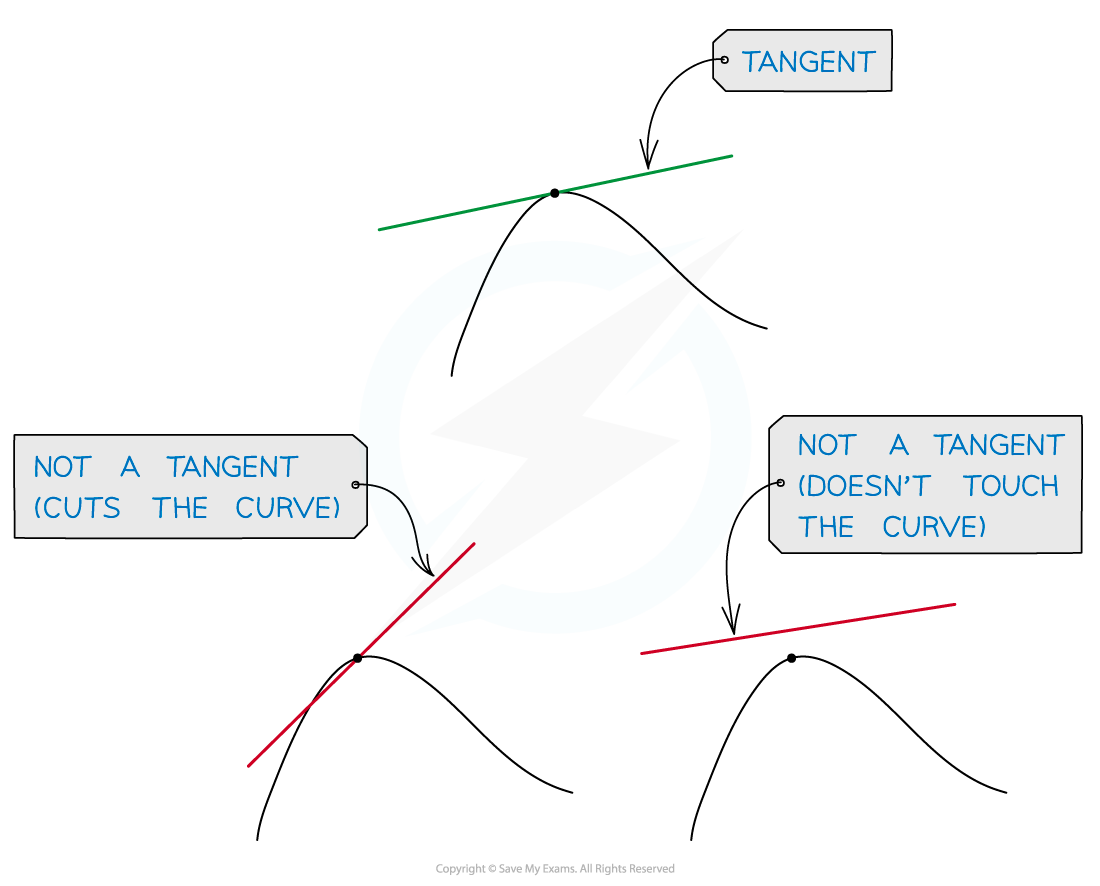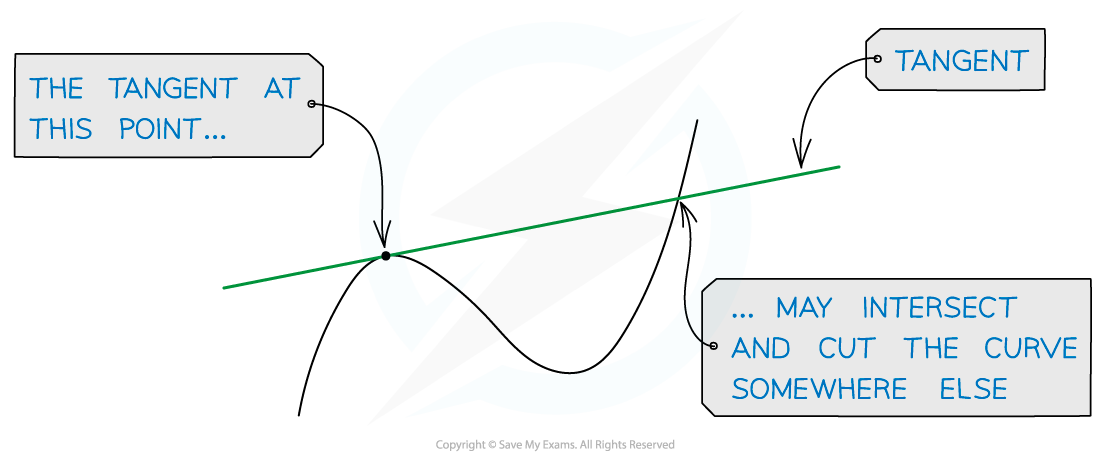Introduction to Differentiation (Cambridge (CIE) IGCSE Additional Maths): Revision Note
Exam code: 606
Did this video help you?
Definition of gradient
What is the gradient of a curve?
At a given point the gradient of a curve is defined as the gradient of the tangent to the curve at that point
A tangent to a curve is a line that just touches the curve at one point but doesn't cut the curve at that point

A tangent may cut the curve somewhere else on the curve

It is only possible to draw one tangent to a curve at any given point
Note that unlike the gradient of a straight line, the gradient of a curve is constantly changing
Examiner Tips and Tricks
If a question asks for the "rate of change of ..." then it is asking for the "gradient"
Worked Example
The diagram shows the curve with equation The tangent,
, to the curve at the point
is also shown.

Using the diagram, calculate the gradient of the curve at .
The gradient of the curve at the point A is the same as the gradient of the tangent T. Calculate the gradient of the line.

The gradient is 3
Definition of derivatives
What is a derivative?
Calculus is about rates of change
the way a car’s position on a road changes is its speed (velocity)
the way the car’s speed changes is its acceleration
The gradient (rate of change) of a (non-linear) function varies with
The derivative of a function is a function that relates the gradient to the value of
For example, the derivative of
is
This means that when
, the gradient of
is
And when
, the gradient of
is
The derivative is also called the gradient function
Worked Example
The derivative of is
.
Use the derivative to find the gradient of at the point
.
Substitute into the derivative,
gradient = 3
Note that the answer is the same as in the method above
Did this video help you?
Differentiating powers of x
What is differentiation?
Differentiation is the process of finding an expression for the derivative (gradient function) from the equation of a curve
The equation of the curve is written
and the gradient function is written
How do I differentiate powers of x?
Powers of
are differentiated according to the following formula:
If
then
e.g. If
then
you "bring down the power" then "subtract one from the power"
Don't forget these two special cases:
If
then
e.g. If
then
If
then
e.g. If
then
These allow you to differentiate linear terms in
and constants
Functions involving fractions with denominators in terms of
will need to be rewritten as negative powers of
first
e.g. If
then rewrite as
and differentiate
How do I differentiate sums and differences of powers of x?
The formulae for differentiating powers of
work for a sum or difference of powers of
e.g. If
then
This is sometimes referred to differentiating 'term-by-term'
Products and quotients (divisions) cannot be differentiated in this way so they need expanding/simplifying first
e.g. If
then expand to
which is a sum/difference of powers of
and can then be differentiated
What can I do with derivatives (gradient functions)?
The derivative can be used to find the gradient of a function at any point
The gradient of a function at a point is equal to the gradient of the tangent to the curve at that point
A question may refer to the gradient of the tangent
Examiner Tips and Tricks
Don't try to do too many steps in your head; write the expression in a format that you can differentiate before you actually differentiate it
e.g.
can be rewritten as
which is then far easier to differentiate
Worked Example
Find the derivative of
(a)
Rewrite the term
Apply the rule for differentiating powers () and apply the special cases for the terms
and 8 (
and
)
Unless a question specifies there is not usually a need to rewrite/simplify the answer
(b)
This is a product of two (equal) brackets so cannot be differentiated directly Expand the brackets to get an expression in powers of Take time to get the expansion correct, writing stages out in full if necessary
Differentiate 'term-by-term', looking out for those special cases
There is a factor of 4 but there is no demand to factorise the final answer in the question
(c)
This is a quotient so cannot be differentiated directly Spot the single denominator which means we can split the fraction by the two terms on the numerator
Simplify using the laws of indices
Each term is now a power of , so differentiate 'term-by-term'
There is demand to simplify or write the answer in a particular form

You've read 0 of your 5 free revision notes this week
Unlock more, it's free!
Did this page help you?